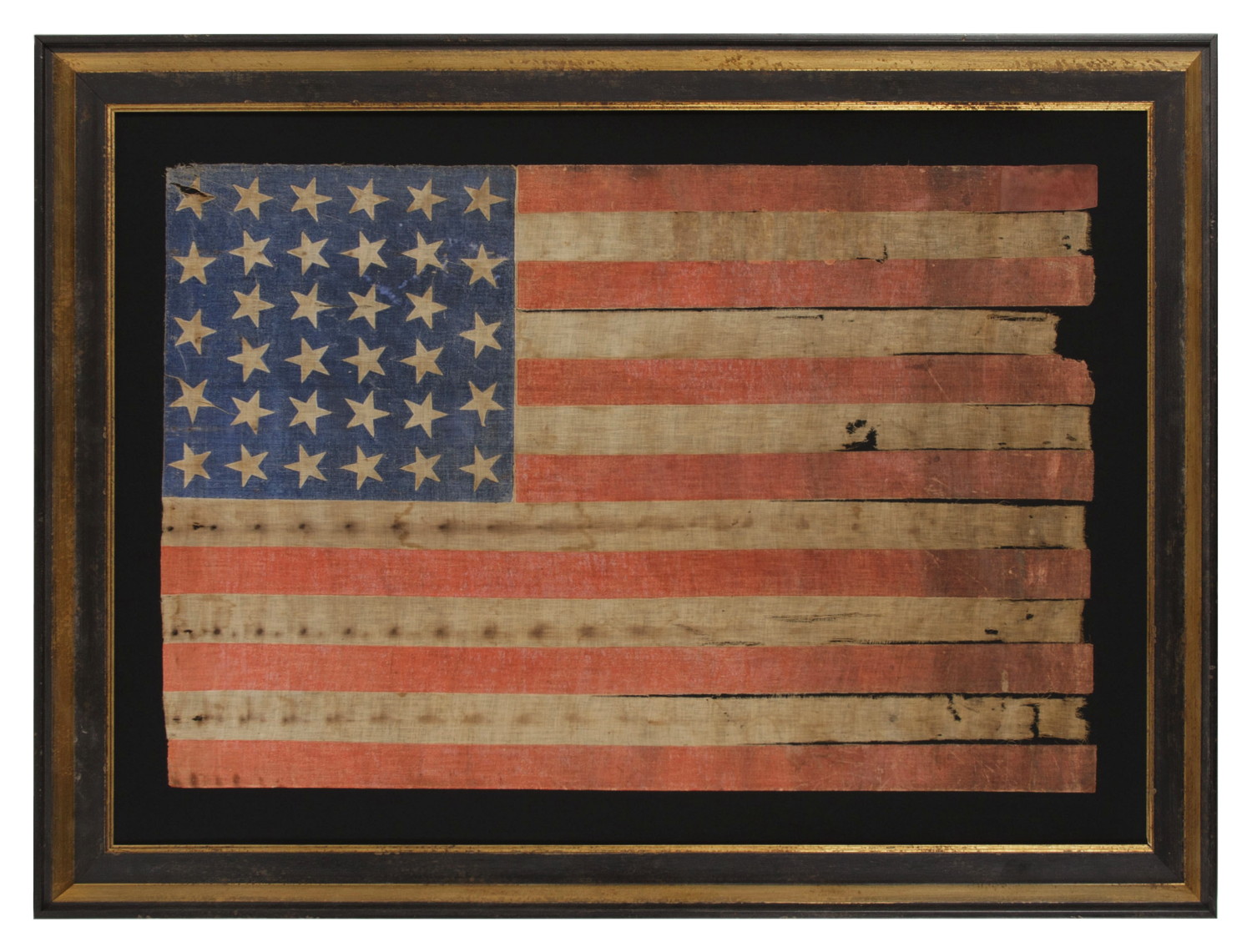


| 34 STARS ON AN ANTIQUE AMERICAN PARADE FLAG OF THE CIVIL WAR PERIOD, LARGE AMONG ITS COUNTERPARTS, WITH EXTENSIVE AND ENDEARING WEAR FROM OBVIOUS LONG-TERM USE; REFLECTS THE ERA WHEN KANSAS WAS THE MOST RECENT STATE TO JOIN THE UNION, 1861-63 |
|
| Web ID: | 34j-950 |
| Available: | In Stock |
| Frame Size (H x L): | 39" x 53.5" |
| Flag Size (H x L): | 28" x 42.5" |
| Description: | |
| 34 star American national flag, printed on fine, glazed cotton, probably with some flax content. Note how the large stars point in various directions on their vertical axis, which adds a whimsical aspect to the presentation. Kansas was admitted into the Union as the 34th state on January 29th, 1861, about 2 ½ months before the Confederate assault on Fort Sumter that marked the beginning of the Civil War. The 34th star was officially added on July 4th of that year, but most flag makers would have added a 34th star with the addition of Kansas in January. The star count remained official until July 4th, 1863, and 34 star flags would have generally been produced until the addition of West Virginia in June of that year. 34 star parade flags are particularly scarce. Prior to the Civil War, Americans did not employ the flag in many of the ways we do today. Before that time private citizens generally did not fly flags off their porches or wave hand-held examples like this one at parades and rallies. Flags were primarily a tool of the military--particularly the U.S. Navy. It wasn't until Confederate forces fired upon Fort Sumter that a surge of patriotism caused a great increase in the making and consumption of the Stars & Stripes by the general public. It was then that flag-makers began to produce them in quantity for the first time. Among known 34 star examples, this is an identified style, produced in several different sizes, among which this is by far the largest of which I am aware. I am privileged to have previously acquired and sold the only other two in this scale that I have ever encountered, and because I know of no others in either institutional or private collections, it presently survives as one of just three that have thus-far surfaced. The size of this flag is among the traits that make it an especially desirable. Few of this period exist in this scale. Parade flags, printed on cotton, silk, or sometimes on wool, were typically feet or less on the fly during the 19th century. In order to be seen at great distance, and thus serve their primary function as signals, flags with pieced-and-sewn construction, were typically 8 feet long and larger. Even infantry battle flags, carried on foot, were 6 x 6.5 feet by Army regulation. Prior to the 1890's, a flag measuring six feet in length was considered small and few of even this scale were produced. Because the average sewn flag can be difficult to conserve and frame, as well as to hang in an indoor setting, while the typical parade flag is less than ideal for a display above a mantelpiece, behind a desk, or the like, many collectors prefer those with strong presence, yet manageable scale, such as this one. Among early flags, those that survive tend to be in better condition than this example. When flags reached a certain point in terms of damage and losses, they were almost universally discarded. This actually creates a scarcity of flags with the sort of wear that this one presents. By the same note, parade flags were generally made for short-term use at parades or political events. This flag was obviously flown for an extended period, perhaps from a porch or business, in heart-felt support for the Union cause. Some examples, when they have reached this manner of condition, are all the more beautiful because of it, with a sensibility similar to that of modern art. In this case the soiling, separations, and fabric loss are so great as to be endearing. The presentation is so rare and visually interesting that it actually becomes a trait that some flag enthusiasts desire, simultaneously drawn by the fact that the state of preservation displays a flag's history in the most open of fashions. In summary, this is a rare and desirable example of the Civil War period with exceptional size, wear, and overall graphics. Mounting: For 25 years we have maintained a specialized department for this purpose. Our lead conservator holds a master's degree in textile conservation from one of the nation’s top university programs. We take great care in the mounting and preservation of flags and related textiles and have preserved thousands of examples. The flag has been hand-stitched to a background of 100% cotton twill, black in color, which was washed and treated for colorfastness. The mount was placed in a black-painted, hand-gilded and distressed Italian molding. The glazing is U.V. protective acrylic (Plexiglas). Condition: There is significant foxing and staining throughout, accompanied by significant separations and wear. A section of the top stripe measuring about 4" in length was absent at the fly end. Fabric of similar coloration was placed behind this area for masking purposes. |
|
| Video: | |
| Collector Level: | Advanced Collectors and the Person with Everything |
| Flag Type: | Parade flag |
| Star Count: | 34 |
| Earliest Date of Origin: | 1861 |
| Latest Date of Origin: | 1863 |
| State/Affiliation: | Kansas |
| War Association: | 1861-1865 Civil War |
| Price: | Please call (717) 676-0545 |
| E-mail: | info@jeffbridgman.com |
 |
|